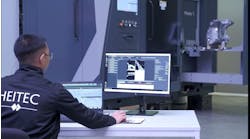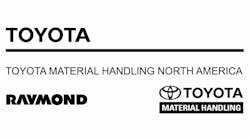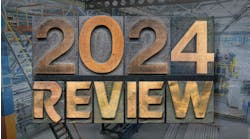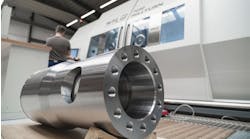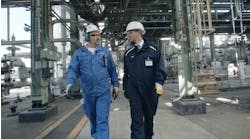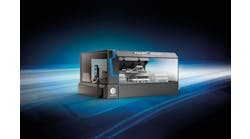Firth Rixson Limited was formed when two separate companies were brought together in February 2003 by The Carlyle Group, a private equity firm. The occasion was the acquisition of Firth Rixson Plc, a public company headquartered in Sheffield, England. It was merged with Forged Metals Inc., based in Fontana, CA, which Carlyle had acquired earlier.
Today, corporate headquarters remain in Sheffield, but the company has also established a U.S. group office in East Hartford, CT. The company has 15 production locations worldwide, approximately 1,900 employees, a diverse portfolio of product capabilities, and a well-developed list of global customers.
Aerospace is FRL’s largest market. The company serves most of the segment’s leading OEMs, directly or indirectly, through numerous aerospace supply chains. Other markets
include industrial gas turbines, off-highway and transportation, energy, railroads and petrochemical.
Firth Rixson serves these markets from three business segments: the first is seamless-rolled and welded rings; next, general industrial forgings; and, finally, metals. The metals segment includes alloy production and metalcasting operations.
After Carlyle acquired FRL, the company reverted to a privately held entity from a publicly traded one. At present, the company does not disclose financial information. However, company officials admit that as of February 2005, two years after its inception, company sales had grown by more than 30%.
In recent months, Firth Rixson has made headlines with three announcements: The signing of an aerospace long-term agreement (LTA) involving a new class of corporate jet aircraft, acquiring Schlosser Forge, and making several major investments in China. These moves, FRL says, are designed to make the company more of a force in global forging.
LTA for Eclipse 500
In March, FRL signed a multi-year deal with Pratt & Whitney Canada, to supply seamless rolled rings and other forgings for the new PW610F engine. The engine design had previously been selected by Eclipse Aviation Corp. to power its new Eclipse 500. This aircraft establishes a new category of aircraft, the Very Light Jet (VLJ).
Announcing the agreement, Firth Rixson CEO Armand F. Lauzon, Jr. said, “This LTA has industry significance for a number of reasons. Not only does the success of the Eclipse 500 create an entirely new category of aircraft, powered by an entirely new jet engine, it also represents for us a new level of supply-chain collaboration, in which members share ambitious affordability, time-to-market, and manufacturing-excellence targets.
He continued, “This partnering approach supports the goal of keeping the acquisition cost of an Eclipse 500 significantly lower than comparable business jets on the market today. The attractive economics of the Eclipse 500 may trigger an expansion of the global market for VLJs that will last for years to come.”
According to Alan Erickson, group vice president for sales and marketing, the Eclipse 500 will be powered by two PW610F engines, each of which will contain 11 seamless rolled rings and up to six forgings from Firth Rixson. “Initial order levels for the Eclipse suggest that the PW610F has the potential to achieve high-volume production rates, making the PW610F engine a significant program for the industry and for Firth Rixson,” he said.
Schlosser Forge acquisition
Firth Rixson acquired Schlosser Forge Co., Rancho Cucamonga, CA, in October 2004. Schlosser specializes in forging seamless rolled rings, primarily for aerospace applications. Company officials view the acquisition as “a really a good strategic fit for FRL, because it expands the company’s technology and product-size range.”
Schlosser gives Firth Rixson the resources to meet a broader range of aerospace customer requirements, particularly in the area of complex configurations. The company believes that following the Schlosser acquisition, it is in a better position to compete in specialized segments of the seamless ring industry.
China investments
FRL is nearing completion of a wholly owned subsidiary operation in Suzhou, a two-hour drive southwest of Shanghai.
The new facility is named Firth Rixson Aerospace Components Co., Ltd. Its new, 50,000 ft2 plant will produce seamless rolled rings, and plans call for it to develop the capabilities to heat treat and perform nondestructive testing on aerospace components. Initially, the output will be sold in China and the Asian region. Eventually, FRL expects this Chinese operation to sell parts globally.
FRL’s leaders regard China as an opportunity, not a threat. According to Lauzon, “China is an enormous market and its people have an enormous appetite for improvement. For the major OEMs who want to participate in this market, building relationships within China is absolutely crucial. By investing now to establish a presence as the first U.K./U.S.-based seamless-ring-roll manufacturer in China, FRL is offering our aerospace OEM customers a key link in their Chinese-based supply chain for serving Chinese and regional end-users.”
The management team
Lauzon has been in place as CEO of FRL since February 2003. Prior to becoming CEO, he was senior vice president of Precision Castparts Corp. HE describes his primary responsibility at Firth Rixson as building the management team that is leading 15 operating units located or under construction in the U.K., U.S., Hungary, and China. His objective is to develop the future leaders of a number forging supply chains, and in the process to establish FRL as a competitive force in changing global markets.
Lauzon brings to FRL 25 years of experience in organizations that supply highly engineered metal components to OEMs in the aerospace, defense, gas turbine, and transportation industries. He holds a bachelor of science degree from the University of Massachusetts and an M.B.A. from the University of New Haven.
In addition leading the group’s strategic planning and team building, Lauzon is directing the installation of numerous customer-focused continuous improvement initiatives throughout the company and spearheading the organization’s establishment its ventures in China.
Forging as an opportunity
Firth Rixson operates four ring mills in the U.S. and three in the U.K. The U.S. ring operations are Forged Metals and Schlosser Forge, in Fontana and Rancho Cucamonga, CA, respectively; Monroe, Rochester, NY; and Viking, Reno, NV. The U.K. ring operations are located in Rotherham, South Yorkshire.
Company officials claim the company offers “the most comprehensive size and alloy range of rolled rings in the world.” Products range in size from 4 to 150 in. diameter; materials include alloy steel, stainless, aluminum, titanium, nickel-based superalloys and copper alloys.
In addition, FRL operates four more forging operations in Europe.
Lauzon and his management team claim to see a business opportunity for a top-notch forging company that can operate cost-effectively anywhere in the world. Their stated aim is to build the company through investments, acquisitions, and divestitures that strengthen Firth Rixson’s global offering. To direct this, Lauzon describes a simple approach:
- Meet the challenges of global competitors.
- Work closely with customers to meet a host of requirements.
- Follow a technical game plan that supports co-located manufacturing.
He believes that the forging industry provides a critical process for multiple supply chains. However, he also believes that many forgers have not modernized as fast as they might, nor have they adapted to the new conditions of changing markets.
In this environment, FRL’s approach is “to do what it takes to move quickly where customers will reward suppliers,” and deliver products faster than others are able. Lauzon says he believes his job is to make sure the company gets better at executing this approach every day.
Cost-pressure challenges
According to FRL’s CEO, “Cost pressures will never go away. In aerospace, they come from the end users at the top of supply chains. They come also from competition and from the metal markets, to name a few more.
“In the face of this pressure, every forger must maintain accurate business systems that provide visibility of financial performance. Such systems can help the management negotiate the market’s cost-reduction demands. Having good financial systems enables a company to know its true costs, and thus to participate fully in growing markets, such as Asia, for which forecasters project a massive demand for new aircraft.
“Global OEMs will be competing aggressively for share in this market. As a supplier, we have an obligation to support our customers. The smaller companies that do not have good financial systems or the capital to expand into emerging and unfamiliar markets are vulnerable to global change and are likely to be consolidated into larger entities that do have solid financial management and capital reserves. Smaller companies are also hurt by rising metal prices, which are a big percentage of the forging cost structure.
“One solution is the consolidation of forging companies, which will also consolidate metal purchasing activity. This, in turn, enhances the buying power of purchasing departments because they become larger and can exert more leverage. When confronting trends in globalization, the companies that will fare well are those with good financial systems, the ability to grow, and the willingness to commit to supporting customers wherever they go to do business.”
Externally, FRL focuses on the wants and needs of its customers, and aggressively maintains intelligence on what its competition is doing. Internally, the company continues to reduce cycle times and operating expense, while closely monitoring working-capital metrics to support its growing operations.
Human capital development
The company has an experienced workforce and strong equipment base in the U.S. and in the U.K., as well as in Hungary. FRL is building on these assets to strengthen its worldwide competitiveness.
In a recent corporate profile, FRL states, “A company is only as good as the people in it. To make our people the best in the business, we are introducing new training and incentive systems companywide.
“We have re-organized the company, integrated new acquisitions, and provided employee incentives to work toward being the best in the industry.”
This is how Lauzon explains the FRL approach to employee development. “There are a number of things we are doing that will build momentum for a ‘human capital’ plan. We have hired Susan Mullen as group vice president of human resources. Sue’s job will be to establish a human resource blueprint we can use throughout the company. It will provide us with a common and consistent approach to the development of our employees.
“One example of what I mean by common approach is variable pay, which creates opportunities for employees to earn bonuses. We have successfully rolled out bonus plans at three of our locations with outstanding results. Implementing variable pay across the remaining 12 facilities is a key ingredient in our plan to educate, motivate and reward employees.”
The introduction of variable-based pay is an approach that the FRL management says will align the workforce with the company’s business objectives. Reportedly, it is already working well in three U.S. operations. The full installation of variable-based pay throughout the organization is expected to establish a reward structure that gives employees strong, positive incentives to make needed changes.
Lauzon states, “To meet our business goals, we’ve simply got to have the best people. We will not succeed competitively if we do not have a top team. To that end, we are going to assemble a top team, then educate and reward its members. This will help us achieve our second goal, strong alignment with customers. Finally, we remain on an acquisition path and-even as we speak-are evaluating multiple companies that could strategically fit into our portfolio.”
Past and future growth
FRL’s recent growth comes from multiple sources. First, it has grown revenues internally by increasing the market shares of existing business. To aid this process, leaders at each operating facility are installing best practices, lean thinking, and Six Sigma tools that improve competitiveness. The improvements achieved by these efforts are helping FRL maximize opportunities to grow sales.
Second, aerospace and other industry segments are now emerging very strongly from the economic downturn that began in 2001. FRL positioned itself to take advantage of improving business conditions in aerospace, as well as in multiple other industry segments.
Third, FRL is investing selectively in different parts of the business where changing market conditions suggest that such investments would be wise. Future investments may be made in existing facilities, new acquisitions, and/or China.
With the Schlosser now integrated into the larger organization, the company is evaluating new targets. FRL’s strategy is to find acquisition prospects that will provide the company with growth opportunities, as well as synergistic benefits with other FRL operations, strategic fit in the many markets the company serves, and competitive enhancements versus other forging providers around the world.
